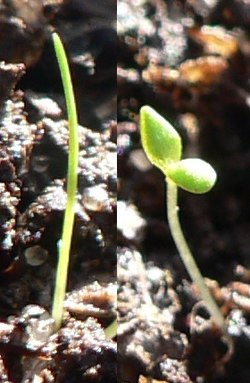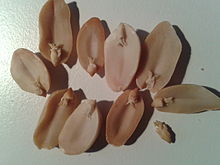Cotyledon

A cotyledon (
gen.
In the case of dicot seedlings whose cotyledons are photosynthetic, the cotyledons are functionally similar to leaves. However, true leaves and cotyledons are developmentally distinct. Cotyledons form during
The cotyledon of grasses and many other monocotyledons is a highly modified leaf composed of a scutellum and a coleoptile. The scutellum is a tissue within the seed that is specialized to absorb stored food from the adjacent endosperm. The coleoptile is a protective cap that covers the plumule (precursor to the stem and leaves of the plant).
Cotyledons may be ephemeral, lasting only days after emergence, or persistent, enduring at least a year on the plant. The cotyledons contain (or in the case of gymnosperms and monocotyledons, have access to) the stored food reserves of the seed. As these reserves are used up, the cotyledons may turn green and begin photosynthesis, or may wither as the first true leaves take over food production for the seedling.[5]
Epigeal versus hypogeal development




Cotyledons may be either epigeal, expanding on the germination of the seed, throwing off the seed shell, rising above the ground, and perhaps becoming photosynthetic; or hypogeal, not expanding, remaining below ground and not becoming photosynthetic. The latter is typically the case where the cotyledons act as a storage organ, as in many nuts and acorns.[citation needed]
Hypogeal plants have (on average) significantly larger seeds than epigeal ones. They are also capable of surviving if the seedling is clipped off, as meristem buds remain underground (with epigeal plants, the meristem is clipped off if the seedling is grazed). The tradeoff is whether the plant should produce a large number of small seeds, or a smaller number of seeds which are more likely to survive.[6][7]
The ultimate development of the epigeal habit is represented by a few plants, mostly in the family Gesneriaceae in which the cotyledon persists for a lifetime. Such a plant is Streptocarpus wendlandii of South Africa in which one cotyledon grows to be up to 75 centimeters (2.5 feet) in length and up to 61 cm (two feet) in width (the largest cotyledon of any dicot,[8] and exceeded only by Lodoicea). Adventitious flower clusters form along the midrib of the cotyledon.[9] The second cotyledon is much smaller and ephemeral.[citation needed]
Related plants may show a mixture of hypogeal and epigeal development, even within the same plant family. Groups which contain both hypogeal and epigeal species include, for example, the Southern Hemisphere conifer family
History
The term cotyledon was coined by Marcello Malpighi (1628–1694).[a] John Ray was the first botanist to recognize that some plants have two and others only one, and eventually the first to recognize the immense importance of this fact to systematics, in Methodus plantarum (1682).[5][13]
Theophrastus (3rd or 4th century BC) and Albertus Magnus (13th century) may also have recognized the distinction between the dicotyledons and monocotyledons.[14][13]
Notes
- placenta.[3]
References
- ^ Short & George 2013, p. 15, [1].
- ISBN 9780849326752. Retrieved 12 May 2024.
Greek kotyle, kotyledon 'a cavity, small cup, any cup-shaped hollow,' in allusion to the receptacle or to the space at the base of the leaves [...].
- ^ a b OED.
- ^ Yamoto, Takakazu; Maruhashi, Tamaki (December 1995). "Seed Dispersal by Elephants...etc". Biotropica. 27 (4): 528.
- ^ a b Vines, Sydney Howard (1913), "Robert Morison 1620—1683 and John Ray 1627—1705", in Oliver, Francis Wall (ed.), Makers of British botany, Cambridge University Press, pp. 8–43
- ^ a b Charles R. Tischler; Justin D. Derner; H. Wayne Polley; Hyrum B. Johnson (2007). Response of Seedlings of Two Hypogeal Brush Species to CO2 Enrichment. Proceedings: Shrubland dynamics -- fire and water; 2004 August 10–12; Lubbock, TX. Proceedings RMRS-P-47. In: Sosebee, Ronald E.; Wester, David B.; Britton, Carlton M.; Mcarthur, E. Durant; Kitchen, Stanley G., Comps. Proceedings: Shrubland Dynamics -- Fire and Water; 2004 August 10–12; Lubbock, Tx. Proceedings RMRS-P-47. Fort Collins, Co: U.S. Department of Agriculture, Forest Service, Rocky Mountain Research Station. P. 104-106. Vol. 047. Fort Collins, CO: U.S. Department of Agriculture, Forest Service, Rocky Mountain Research Station. pp. 104–106.
- S2CID 24272337
- PMID 15286012.
- ^ Perry, Frances and Leslie Greenwood (1972). Flowers of the World. London: Hamlyn Publishing Group. p. 47.
- PMID 21680310
- ^ Linnaeus 1751, p. 54.
- ^ Linnaeus 1751, p. 89.
- ^ ISBN 978-0-8047-1075-6.
- ^ "Bioetymology: Origin in Biomedical Terms: cotyledon, monocotyledon (plural usually monocots), dicotyledons(plural usually dicot)". bioetymology.blogspot.com.br. Retrieved 6 April 2018.
Bibliography
- Linnaeus, Carl (1755) [1751]. Philosophia botanica : in qua explicantur fundamenta botanica cum definitionibus partium, exemplis terminorum, observationibus rariorum, adiectis figuris aeneis. originally published simultaneously by R. Kiesewetter (Stockholm) and Z. Chatelain (Amsterdam). Vienna: Joannis Thomae Trattner. Retrieved 13 December 2015.
- Mirov, N. T. (1967). The Genus Pinus. Ronald Press Company, New York.
- Farjon, A. & Styles, B. T. (1997). Pinus (Pinaceae). Flora Neotropica Monograph 75: 221–224.
- "Cotyledon". Oxford English Dictionary (Online ed.). Oxford University Press. (Subscription or participating institution membership required.)
- Short, Emma; George, Alex (2013). A primer of botanical Latin with vocabulary. New York: Cambridge University Press. ISBN 9781107693753. Retrieved 14 December 2015.
